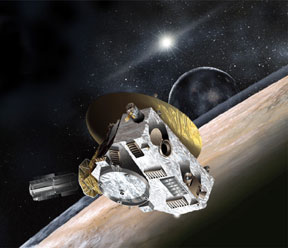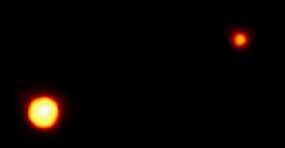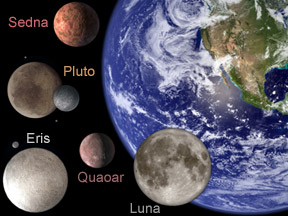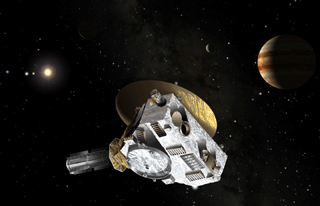Click on image for full size
Image courtesy Johns Hopkins University Applied Physics Laboratory/Southwest Research Institute.
Related links:
Animation of the New Horizons mission (6.4 MB QuickTime)
Video of the launch of the New Horizons mission (5.5 MB MPEG)
Animation of the trajectory of New Horizons through our Solar System (4.7 MB QuickTime)
New Horizons mission site at Johns Hopkins University Applied Physics Laboratory
New Horizons Mission to Pluto
A NASA spacecraft is on its way to Pluto. The spacecraft, named New Horizons, will be the first mission to visit that frozen world on the outer fringes of our Solar System. New Horizons was launched from Florida in January 2006. The spacecraft has a long journey ahead of it... it won't reach Pluto until 2015!
New Horizons will study Pluto and its large moon Charon during a 5-month long flyby of this binary planet system. Afterwards, NASA hopes to send the spacecraft on an extended mission to one or more Kuiper Belt objects. Since many new Kuiper Belt Objects (KBOs) will probably be discovered while New Horizons is en route to Pluto, NASA hasn't yet decided which KBO(s) the spacecraft will attempt to explore.
This mission will in some ways complete humanity's initial robotic exploration of the planets in our Solar System, since Pluto is the only one of the nine traditional planets that hasn't yet been visited by a spacecraft. Of course, there has been a debate amongst astronomers about Pluto's status as a planet. Since many KBOs similar to Pluto have been found in recent years, some scientists believe Pluto shouldn't really be called a planet at all. In August 2006, the International Astronomical Union (IAU) officially demoted Pluto's status to that of a "dwarf planet". However, some scientists still think that Pluto should still be considered a planet for historical reasons. In any case, New Horizons promises to give us our first good look at Pluto and the Kuiper Belt if this lengthy mission to the frozen fringe of our Solar System succeeds!
After its launch onboard an Atlas V vehicle from Cape Canaveral at 2 PM on January 19, 2006, New Horizons rocketed away from our planet at the highest speed of any spacecraft leaving Earth so far... it was traveling at 16.21 km/s (36,300 mph) when its engine shut down! The speedy spacecraft zoomed past the Moon's orbit just nine hours later... a much quicker trip than the three days required by Apollo astronauts to reach our Moon. New Horizons crossed the orbit of Mars on April 7, 2006 and entered the asteroid belt in early May 2006. During the first few months of the spacecraft's long journey to Pluto, scientists have been testing New Horizon's instruments; everything seems to be working fine so far! The spacecraft passed within 102 thousand km (63 thousand miles) of main belt asteroid 2002 JF56 on June 13, 2006 and took pictures of it. While still in the asteroid belt, New Horizons used its Long Range Reconnaissance Imager (LORRI) to shoot its very first photo of Pluto as part of an optical navigation test in September 2006. The spacecraft left the asteroid belt without incident in late October 2006.
New Horizons will slingshot past Jupiter on February 28, 2007, boosting the spacecraft's speed by 4 km/s (9,000 mph) as the powerful gravity of the giant planet flings the ship onwards towards Pluto. In fact, the gravity assist from Jupiter will cut several years off of New Horizon's trip to Pluto. The spacecraft is scheduled to finally reach that frozen world on July 14, 2015. It will be traveling at a speed of roughly 13.8 km/s (about 31 thousand mph) as it passes within 10,000 km (6,200 miles) of Pluto. Fourteen minutes after its closest approach to Pluto, New Horizons will fly by the large moon Charon at a distance of 27,000 km (16,800 miles). After that, the spacecraft will cruise for several more years, finally encountering one or more Kuiper Belt Objects sometime between 2016 and 2020.
Here are a few odd bits of trivia about the New Horizons mission:
- Some of the ashes of the astronomer who discovered Pluto, Clyde Tombaugh, were placed aboard the spacecraft before it was launched.
- A Florida state quarter, bearing an image of the Space Shuttle, was used on the spacecraft as part of a balancing weight.
- Two new small moons of Pluto that were discovered by the Hubble Space Telescope in 2005 have been given the names Nix and Hydra. Besides the fact that Nyx and Hydra are mythological figures associated with the Roman god Pluto, the names were chosen because the first letters of the names (N & H) are the initials of New Horizons.













